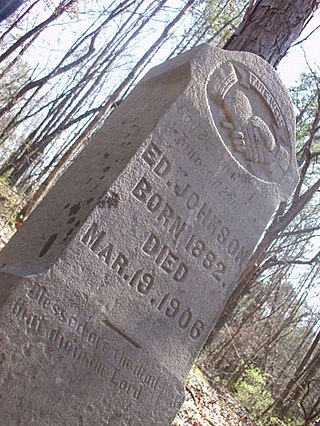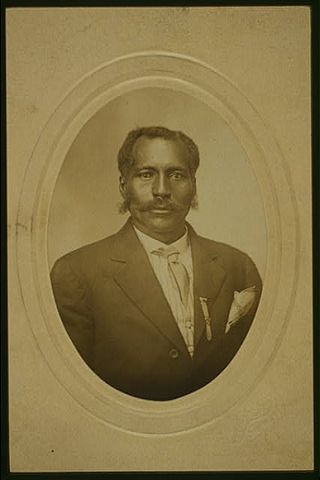Related Research Articles

The Marrow of Tradition (1901) is a novel by the African-American author Charles W. Chesnutt, portraying a fictional account of the Wilmington Insurrection of 1898 in Wilmington, North Carolina, an event that had just recently occurred.
Raymond Gunn was a black man killed by a mob in Maryville, Missouri, United States, after being accused of killing a white woman.
On May 16, 1918, a plantation owner was murdered, prompting a manhunt which resulted in a series of lynchings in May 1918 in southern Georgia, United States. White people killed at least 13 black people during the next two weeks. Among those killed were Hazel "Hayes" Turner and his wife, Mary Turner. Hayes was killed on May 18, and the next day, his pregnant wife Mary was strung up by her feet, doused with gasoline and oil then set on fire. Mary's unborn child was cut from her abdomen and stomped to death. Her body was then repeatedly shot. No one was ever convicted of her lynching.
White caps were groups involved in the whitecapping movement who were operating in southern Indiana in the late 19th century. They engaged in vigilante justice and lynchings, with modern viewpoints describing their actions as domestic terrorism. They became common in the state following the American Civil War and lasted until the turn of the 20th century. White caps were especially active in Crawford and neighboring counties in the late 1880s. Several members of the Reno Gang were lynched in 1868, causing an international incident. Some of the members had been extradited to the United States from Canada and were supposed to be under federal protection. Lynchings continued against other criminals, but when two possibly innocent men were killed in Corydon in 1889, Indiana responded by cracking down on the white cap vigilante groups, beginning in the administration of Isaac P. Gray.

On March 19, 1906, Ed Johnson, a young African American man, was murdered by a lynch mob in his home town of Chattanooga, Tennessee. He had been sentenced to death for the rape of Nevada Taylor, but Justice John Marshall Harlan of the United States Supreme Court had issued a stay of execution. To prevent delay or avoidance of execution, a mob broke into the jail where Johnson was held, and abducted and lynched him from the Walnut Street Bridge.

Anthony Crawford was an African American man who was killed by a lynch mob in Abbeville, South Carolina on October 21, 1916.

Laura and L. D. Nelson were an African-American mother and son who were lynched on May 25, 1911, near Okemah, Okfuskee County, Oklahoma. They had been seized from their cells in the Okemah county jail the night before by a group of up to 40 white men, reportedly including Charley Guthrie, father of the folk singer Woody Guthrie. The Associated Press reported that Laura was raped. She and L. D. were then hanged from a bridge over the North Canadian River. According to one source, Laura had a baby with her who survived the attack.

The lynching of Francis McIntosh was the killing of a free Black man, a boatman, by a white mob after he was arrested in St. Louis, Missouri, on April 28, 1836. He had fatally stabbed one policeman and injured a second.

In Forsyth County, Georgia, in September 1912, two separate alleged attacks on white women in the Cumming area resulted in black men being accused as suspects. First, a white woman reportedly awoke to find a black man in her bedroom; then days later, a white teenage girl was beaten and raped, later dying of her injuries.
Claude Neal was a 23-year-old African-American farmhand who was arrested in Jackson County, Florida, on October 19, 1934, for allegedly raping and killing Lola Cannady, a 19-year-old white woman missing since the preceding night. Circumstantial evidence was collected against him, but nothing directly linked him to the crime. When the news got out about his arrest, white lynch mobs began to form. In order to keep Neal safe, County Sheriff Flake Chambliss moved him between multiple jails, including the county jail at Brewton, Alabama, 100 miles (160 km) away. But a lynch mob of about 100 white men from Jackson County heard where he was, and brought him back to Jackson County.

The Perry massacre was a racially motivated conflict in Perry, Florida, in December 1922. Whites killed four black men, including Charles Wright, who was lynched by being burned at the stake, and they also destroyed several buildings in the black community of Perry after the murder of Ruby Hendry, a white female schoolteacher.
The lynching of Marie Thompson of Shepherdsville took place in the early morning on June 15, 1904, in Lebanon Junction, Bullitt County, Kentucky, for her killing of John Irvin, a white landowner. The day before Thompson had attempted to defend her son from being beaten by Irvin in a dispute; he ordered her off the land. As she was walking away from him, he attacked her with a knife and she killed him in self-defense with a razor. She was arrested and put in the county jail.
George Armwood was an African American who was lynched in Princess Anne, Maryland, on October 18, 1933. His murder was the last recorded lynching in Maryland.
Cheyenne Wildcat is a 1944 American Western film directed by Lesley Selander and one of the 23 Republic Pictures Red Ryder features. The film, starring veteran western actor, Wild Bill Elliott as Red Ryder, was based on the comic strip "Red Ryder" created by Fred Harman (1938–1964), and licensed through a special arrangement with Stephen Slesinger. Costarring as Little Beaver, was actor Robert Blake.

William "Froggie" James, an African-American man, was lynched and his dead body mutilated on November 11, 1909 by a mob in Cairo, Illinois, after he was charged with the rape and murder of 23-year-old shop clerk Anna Pelley.

On April 13, 1937, Roosevelt Townes and Robert McDaniels, two black men, were lynched in Duck Hill, Mississippi by a white mob after being labeled as the murderers of a white storekeeper. They had only been legally accused of the crime a few minutes before they were kidnapped from the courthouse, chained to trees, and tortured with a blow torch. Following the torture, McDaniels was shot to death and Townes was burned alive.

The lynching of Paul Reed and Will Cato occurred in Statesboro, Georgia on August 16, 1904. Five members of a white farm family, the Hodges, had been murdered and their house burned to hide the crime. Paul Reed and Will Cato, who were African-American, were tried and convicted for the murders. Despite militia having been brought in from Savannah to protect them, the two men were taken by a mob from the courthouse immediately after their trials, chained to a tree stump, and burned. In the immediate aftermath, four more African-Americans were shot, three of them dying, and others were flogged.

Reprisal! is a 1956 American Western film directed by George Sherman and starring Guy Madison, Felicia Farr and Kathryn Grant. The film's sets were designed by the art director Walter Holscher.
Leonard Woods was an African-American man who was lynched by a mob in Pound Gap, on the border between Kentucky and Virginia, after they broke him out of jail in Whitesburg, Kentucky, on November 30, 1927. Woods was alleged to have killed the foreman of a mine, Herschel Deaton. A mob of people from Kentucky and Virginia took him from the jail and away from town and hanged him, and riddled his body with shots. The killing, which became widely publicized, was the last in a long line of extrajudicial murders in the area, and, prompted by the activism of Louis Isaac Jaffe and others, resulted in the adoption of strong anti-lynching legislation in Virginia.

The lynching of Richard Puryear took place on March 15, 1894, at Stroudsburg, Monroe County, in the U.S. state of Pennsylvania. A mostly white mob seized and hanged Richard Puryear, a Black railroad worker accused of murdering a white storekeeper, after he escaped from prison. A grand jury investigated the lynching, but no members of the mob faced criminal charges or convictions in Puryear's murder.
References
- 1 2 3 Charles, Chesnutt. "The Sheriff's Children". The Charles Chesnutt Digital Archive. Retrieved 21 February 2017.
- ↑ Haslam, Gerald W. (Summer 1968). ""The Sheriff's Children": Chesnutt's Tragic Racial Parable". Negro American Literature Forum. 2 (2): 21–26. JSTOR 3041214.
- ↑ "The Sheriff's Children". Encyclopedia.com. Retrieved 21 February 2017.
- ↑ Delmar, P. Jay (Nov 1979). "The Mask as Theme and Structure: Charles W. Chesnutt's "The Sheriff's Children" and "The Passing of Grandison"". American Literature. 51 (3): 364–375. JSTOR 2925391.